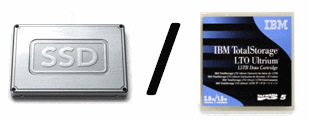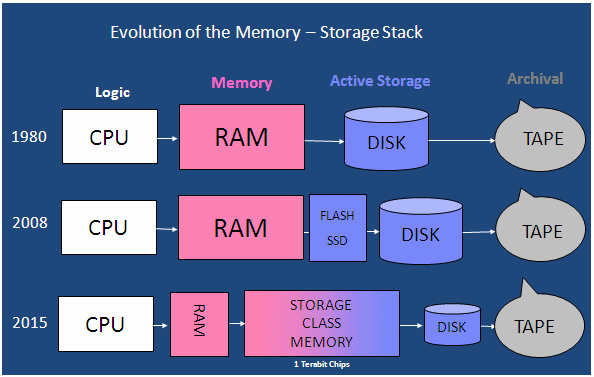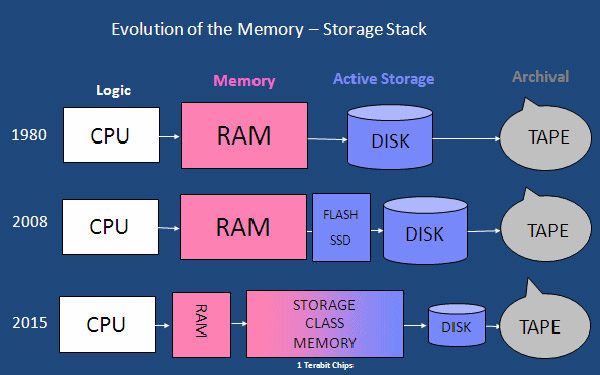
Last week, in the midst of doing research on Flash/SSD I spent a good deal of time speaking to one of the foremost experts on the topic, David Floyer at Wikibon. We were discussing the fact that once Flash is cost effective enough (and we are almost there), and there is software robust enough to push the less important data to cheaper storage, as long as I can access that storage when I need it, then the need for spinning disk between flash and tape could become unnecessary. Hence David coined the term “Flape”; a combination of flash and tape. I then had a subsequent conversation with my good friend and industry knowledge sponge, Rich Pappas at Proximal Data. Rich, correctly informed me you can’t leave cloud out of said conversation, so I then needed to coin the term “Floud” (yes, a combination of flash and could).

Why would this be possible? Take tape for example. Over the last two decades I have been in this business, tape has been killed off more than a bad guy in a James Bond movie, the issue is someone forgot to tell IBM. IBM just released LTO6 in October. LTO6 has 2.5x better compressed capacity than LTO5. You can store up to 6.25TB of data on a single cartridge. In addition, LTO6 has 40% more compressed data transfer rate than Gen5 LTO drives (400 MB/s vs 280MB/s) as well as being 30% more energy efficient than LTO5. Let’s think of the last time traditional disk increased in its performance 40%. Today we can’t spin disk any faster or add more heads to a disk to try to get data off a HDD any faster. Tape just keeps getting more economical and its performance gets better and better.
Now add to the equation the number of vendors who are making cloud “on ramp” appliance to cache and move data into the cloud with good performance. With data growing and the rate it is today, customers are going to need a great deal of inexpensive storage and the cloud offers that.
But here is what will be the real trick. Intelligent data placement. Technologies like EasyTier are going to be paramount to ensure data is placed on the right tier of storage to maximize performance and minimize costs. Getting the data as close to the CPU as possible removes the latency issues applications have when performing analytics.

EasyTier has the capability to automatically move the most important data or “hottest” data to flash/SSD, anywhere in the storage stack, from the array, to network flash/SSD device as well as to server flash/SSD devices in order to increase performance and reduce latency. EasyTier also tiers the less important data to a slower tier of storage to save money. Over time, EasyTier, in conjunction with LTFS (which IBM just announced for Window’s environments), could tier data from flash to tape, hence Flape and I would bet, given that cloud technologies are being deployed more and more, and the “on ramp” technologies look like just another disk tier, I am sure the bright minds at IBM could tier to those devices as well, and then you have Floud.
As customers deploy more flash storage to increase application performance in order to gain a competitive advantage, customers are also going to be looking for solutions that allow them to store even more data less expensively. A Flape architecture may not be out of the question for customers. With intelligent data placement software and the performance capabilities of tape today, customers should be thinking about how this type of architecture can save them a great deal of money while meeting the business performance requirements. And here is why saving money is going to become increasingly more important. As flash, and capabilities such as race track memory (invented by IBM) move closer to the CPU, applications are going to have to be rewritten to write data to this new persistent storage layer that avoids the latency issues cased by the current SCSI and FC protocols, a good deal of money will be spent on this new/updated software. We are seeing early signs that this will be a trend. If you take a look at what Fusion I/O and Intel are doing, creating APIs that allow applications to do what is termed “atomic writes” to flash, bypassing the SCSI protocols and reduce latency.
So, a flape or floud architecture will not be out of the question in the future. And, again, for the record, tape is not dead, it is alive and strong and growing, we are constantly finding new use cases where tape meets and even exceeds business requirements while being very economical. Just like EMC did an about face on heterogeneous virtualization, they will probably have to do the same thing when I comes to tape as customers and customers budgets are going to drive these new solutions.
For the record, If you’re interested in getting a good education on Flash/SSD, as I said before David Floyer at Wikibon has written a great deal of info on the subject and here are a few links to his stuff.
- Case Study: The Hunting of the RARC
- Fusion-io Previews Auto Commit Memory
- Gelsinger Maritz Management Swap Signals New Era in Enterprise Computing
- What Storage Folks do not get about Fusion-io
- Fusion-io Revolutionizes Flash Storage Management with VSL
- Designing Systems and Infrastructure in the Big Data IO Centric Era
- Assessment of EMC Project Thunder, Server Area Networks
- 2011 Flash Memory Summit Enterprise Roundup
